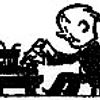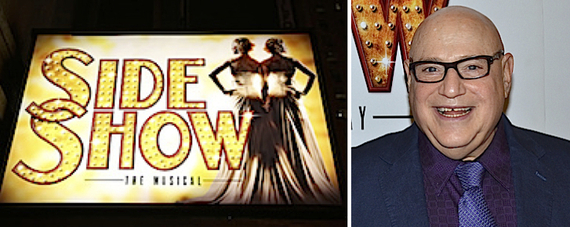I saw it first. Well, not quite. The rapturous critical reception that has greeted the revival of Side Show on Broadway takes me back, way back, to a demonstration of Side Show's unique power that I witnessed firsthand quite some time ago.
The year was 1993, and my friend Henry Krieger, the powerhouse Broadway composer best known for Dreamgirls, had been away from Broadway for almost a decade and was looking to return. I really wanted to see him get to work his magic again. All of his friends did. Henry, as a friend, was (and remains) quite a maternally protective character; qualities that he, in turn, tends to bring out in those close to him.
When Henry introduced me to two new guys with whom he'd begun to write a new show - Bill Russell, a writer, and Robert Longbottom, a director and choreographer - I was delighted. When he told me that the subject of their show was a pair of Siamese twins, I was, I admit it...concerned.
Then Henry began to play the songs that Bill Russell's script and lyrics were pulling out of him. Such anthems of devotion and frustration, determination and pain. They practically rocked the walls of Henry's modest Greenwich Village apartment when Henry sang, his thick fingers rolling out great barrel chords on the baby grand in his narrow living room.
I got to hang out with Bobby and Bill at Henry's place. Lovely fellows. Their passion for the true story of the Hilton Sisters was contagious; joined at the hip twins who became vaudeville sensations and wound up in Hollywood as stars of Todd Browning's immortal 1932 horror flick, Freaks. Still, I had trouble picturing the whole freaky business onstage. The imagined reality of "Stuck on You," as one of Henry and Bill's songs had it, was not appetizing.
And then, one day, a phone call from Henry: Side Show at long last was ready for its backers' audition. This was, by now, 1996. An afternoon reading had been scheduled for March 8, a Friday; just in time to catch Broadway producers on their way out of town for the weekend.
"Bobby, Bill and I think you should read stage directions," I heard Henry say. "What do you think?"
Me? Do what?
Delivering stage directions out loud in an unstaged, or even semi-staged, reading is critical for an audience to visualize what it cannot see. This, I knew. I have never, ever, wanted to be a performer. This, I also knew. But was reading stage directions performing exactly? Well...yeah.
I can calmly address all of this now, more or less. At that moment, on the phone with Henry, I simply froze.
"Barry?"
"........"
"Is that a yes?"
I chewed on his question for another moment.
"Yes."
I practiced my "lines" for weeks. I know Bobby Longbottom rehearsed the actors as much as he was allowed to; Actors' Equity-sanctioned readings are strictly limited to 29 hours total - for rehearsals, plus performance.
Of course, Bobby never rehearsed me. There was no time. I was on my own.
I can still picture the room as I walked into it that afternoon. Lord, it seemed big. This was one of the palatial rehearsal studios that Michael Bennett built at 890 Broadway. Buffed wood floors. Draped mirrored walls. There were folding chairs, music stands, bottles of water at each place, and one chair set slightly apart. Opposite all of this: a flock of chairs in neat rows awaiting - the audience.
I crossed the room and joined the cast. That was a new sensation. I remember Emily Skinner was there; destined for stardom as Daisy Hilton. So was Jeff McCarthy, who would play Terry Connor on Broadway. Alice Ripley was not present that afternoon; undiscovered, as yet, as Violet. Hard to believe.
I watched the audience amble in. There were faces I knew - producers I'd met before - and plenty I didn't know. At length, I saw all of them lift their faces...to me. Right! Mine was the first line.
"Curtain up." I delivered it flawlessly.
I had never before experienced a show from the other side; never watched an audience as it watched me. I studied the crowd. It was easy to see when this musical was working for them and when it wasn't. Engrossed as they clearly were, discomfort - when it surfaced - seemed almost to hollow their bodies defensively inward.
But, oh, when Side Show got them... when Daisy and Violet stood side by side and wailed, "Who will love me as I am?" - I saw seasoned producers literally weep. I remember Manny Azenberg - destined to become the show's lead producer - fairly bawling. Amazing. Even then, it was clear that Side Show did not always work. But when it did - look out!
By the end of that afternoon, the money to take Side Show to Broadway was on the table. Literally.
I was in the house (the Richard Rodgers Theatre) on opening night, October 16, 1997, but lost touch with Henry after Side Show closed ninety-one performances later; widely embraced, but a cult failure. Marriage and kids drew me away, causing me to miss out almost entirely on Henry's Hollywood period, when the Dreamgirls movie was made and Henry collected Oscar nominations. We spoke on the phone and made plans to get together but...
I was tickled to have an excuse to call him for this story. Henry and I talked just a week before a reimagined Side Show reopened on Broadway at the St. James Theatre on November 17, directed by Bill Condon, director of the Dreamgirls film. We picked up pretty much where we'd left off.
"It's changed a lot since you read stage directions," Henry began, laughing. "There are songs you heard in my apartment that did not make it to Broadway then, that are in the show now. Remember 'Stuck With You'?"
I did.
"That was the first song Bill and I wrote together. It now opens the second act."
"What about, Bobby?" I wondered. "What's it like without Bobby Longbottom directing and choreographing?"
"Bobby's original was film noir," Henry replied. "You know, very stark. Bill Condon's present version is technicolor. Movie make-up and masks. Less minimalistic and more in your face. Bobby's fine with it all. You know, Side Show was his idea from the start. He's happy to see it have a new life."
"How did it happen," I asked, "this new life?"
"When Bill Condon was finishing up filming Dreamgirls, I told him that I would love to do a stage musical with him one day, and Bill said he would love to also. For a while, he was interested in directing Side Show as a film, but we finally decided to try for Broadway again."
Henry paused. I knew what he was thinking. Side Show's sudden unhappy ending seventeen years ago had shaken Henry to his soul.
"It took me a year to come out of having the bends, if you will, after we closed the first time," he said to me now. "We'd spent five years bringing Side Show to Broadway. You know, it was a shared culture for Bobby, Bill and me. It was very much in our blood. To have that dashed was hard to recover from. But now the full circle of it all is just..." Henry sighed. "...Great! It's so great. The world has changed since 1997. The idea of 'freaks' being just like us is easier for people to hear. And, somehow, Side Show didn't die. It didn't die."

